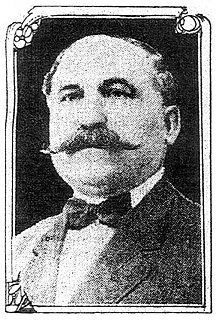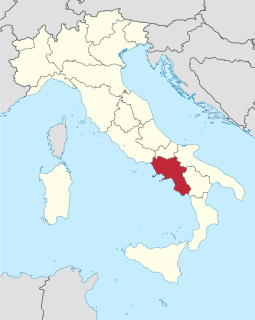The Castellammarese War was a bloody power struggle for control of the Italian-American Mafia, from February, 1930 to April 15, 1931, between partisans of Joe "The Boss" Masseria and those of Salvatore Maranzano. It was so called because Maranzano was based in Castellammare del Golfo, Sicily. Maranzano's faction won, and he declared himself capo di tutti capi, the undisputed leader of the entire Mafia. However, he was soon murdered in turn by a faction of young upstarts led by Lucky Luciano, who established a power-sharing arrangement called "The Commission", a group of five Mafia families of equal stature, to avoid such wars in the future.
See also: 1915 in organized crime, other events of 1916, 1917 in organized crime and the list of 'years in organized crime'.
Nicolò Terranova, also known as Nicholas "Nick" Morello, was one of the first Italian-American organized crime figures in New York City. Along with his half-brother Giuseppe Morello and brothers Ciro and Vincenzo Terranova, he founded the Morello crime family, and was later one of the participants in the Mafia-Camorra War of 1914-17.
Manfredi "Al" or "Alfred" Mineo was a Brooklyn-based New York mobster, who headed a strong American Mafia crime family during the Castellammarese War. Mineo's organization would eventually become the present-day Gambino crime family.

The Morello crime family was one of the earliest crime families to be established in the United States and New York City. The Morellos were based in Manhattan's Italian Harlem and eventually gained dominance in the Italian underworld by defeating the rival Neapolitan Camorra of Brooklyn.

Organized crime in Italy and its criminal organizations have been prevalent in Italy, especially Southern Italy, for centuries and have affected the social and economic life of many Italian regions since at least the 19th century.
Stefano "Steve" Ferrigno was a New York City mobster of Sicilian origin who led an important Italian criminal gang in the 1920s. Ferrigno was murdered along with Alfred Mineo during the so-called Castellammarese War.

Ciro Terranova was an Italian-born New York City gangster and one time underboss of the Morello crime family.
Alfonso Sgroia also known as "The Butcher" was a New York gang member who became a hitman for the Neapolitan Camorra gang.
A crime family is a unit of an organized crime syndicate, particularly the Mafia, often operating within a specific geographic territory. In its strictest sense, a family is a criminal gang, operating either on a unitary basis or as an organized collection of smaller gangs. In turn, a family can be a sole "enterprise", or part of a larger syndicate or cartel.
The Mafia–Camorra War was a gang war in New York City that lasted from 1915-1917. On one side was the originally Sicilian Morello crime family of Manhattan; on the other side were gangs originally from Naples and the surrounding Campania region, based in Navy Street in Brooklyn and Coney Island referred to as the Camorra. The fight over the control of the New York rackets started after the killing of Giosue Gallucci, the undisputed King of Little Italy, and his son on May 17, 1915. The trials that followed in 1918 completely smashed the Camorra gangs; the protection that they enjoyed was demolished from the testimonies of their own men. It was the end of the Camorra in New York and the rise in power of American-based Sicilian Mafia groups.
Rocco Valenti was a New York City gangster and prominent member of the Camorra in New York during the early 1910s.

Ralph "The Barber" Daniello (1886–1925) was a New York criminal who belonged to the Brooklyn Navy Street Gang and participated in a major gang slaying. Daniello eventually became an informant and helped destroy the Camorra crime gangs in Brooklyn.
The 116th Street crew, also known as the Uptown crew, is a powerful crew within the Genovese crime family. In the early 1960s, Anthony Salerno became one of the most powerful capos in the family. Salerno based the crew out of the Palma Boys Social Club located 416 East 115th Street in East Harlem, Manhattan. By the late 1970s and early 1980s, the 116th Street crew had absorbed and initiated many former members of the vicious East Harlem Purple Gang, an Italian-American murder for hire and drug trafficking gang operating in 1970s Italian Harlem and acting generally independent of the Mafia.
The American Mafia, commonly referred to as "the Mafia" or sometimes "the Mob", though "the Mafia" can also refer to the original Sicilian Mafia, while "the Mob" can refer to other organized crime groups or organized crime in general, or Italian-American Mafia, is a highly organized Italian-American criminal society. The organization is often referred to by members as Cosa Nostra and by the government as La Cosa Nostra (LCN). The organization's name is derived from the original Mafia or Cosa nostra, the Sicilian Mafia, and it originally emerged as an offshoot of the Sicilian Mafia; however, the organization eventually encompassed or absorbed other Italian-American gangsters and Italian-American crime groups living in the United States and Canada that are not of Sicilian origin. It is often colloquially referred to as the Italian Mafia or Italian Mob, though these terms may also apply to the separate yet related Sicilian Mafia or other organized crime groups in Italy.

Giosuè Gallucci, also known as Luccariello, was a crime boss of Italian Harlem in New York City affiliated with the Camorra. He dominated the area from 1910–1915 and was also known as the undisputed "King of Little Italy" and "The Mayor of Little Italy", partly due to his political connections. He held strict control over the policy game, employing Neapolitan and Sicilian street gangs as his enforcers.

Nicolo "Cola" Schiro was an early Sicilian-born New York City mobster. In 1912, he became the boss of the mafia gang that later became known as the Bonanno crime family. After nearly two decades as boss, a conflict with rival gangster Joe Masseria in 1930 would force Schiro out and elevate Salvatore Maranzano as his replacement. Following his ouster, Schiro returned to Sicily.



















